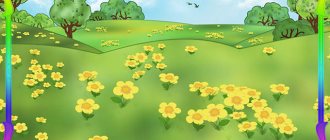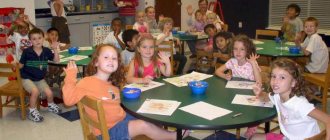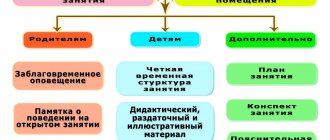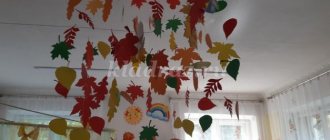The purpose of an open lesson on speech development
Introductory lessons in kindergartens are held to demonstrate teaching methods and are intended not only for parents, but also for the exchange of experience between teachers.
Features of development
The first youngest group is considered to be children 2-3 years old. Speech development at this age occurs through imitation of adults by recognizing sounds and observing lip movements.
Note! In the presence of children, you should speak correctly and clearly. Articulation in babies is just beginning to develop, so the pronunciation of “R”, “L” and hissing sounds suffers, which children replace with whistling sounds as easier.
As the speech apparatus develops and the vocabulary is replenished, the child’s speech becomes more understandable and clear, phrases more fully reflect the intentions of the little person.
Norms of speech development
Forming verbal communication skills is a fairly individual process, but there are a number of criteria developed to assess speech development.
In the first junior group they are as follows:
- ability to speak in phrases, simple sentences;
- the ability to give a subject assessment: the winter is cold, the toy is soft;
- mastery of the skill of coordinating an object and an action: a cat meows, a person walks;
- ability to name objects in pictures.
Vocabulary by the age of three reaches 1500 words.
Important! These indicators are not unambiguous criteria for assessing the baby’s health. They are designed to guide the dynamics of a child’s development and serve as a support for children’s learning.
Summary of an open lesson on FEMP in the first junior group “Geometric Figures”
The teacher suggests tracing a circle with your finger.
Educator: Let's look further:
- I have three tops, three corners, three sides. Who am I?
Children: Triangle.
He takes out a triangle and attaches it next to the circle: “What else did the Bunny bring us? What is the name of this figure?
The teacher invites the children to repeat the name of the figure in chorus, and for some children to show its sides and angles.
Educator: Well done! And here is another figure:
“I’m not an oval, I’m not a circle, I’m not a friend to a triangle,
This is the kind of brother I am.
And my name is...
Children: Square.
Then he takes out a square, places it next to the triangle, names the figure, shows the sides and corners of the square and asks the children: “What does a square have? How many sides does a square have? How many angles does a square have?
The teacher asks the children to circle the square and show its sides (corners).
The teacher summarizes the children's answers and actions.
part 2
. Educator: “What great fellows you all are. They correctly named all the geometric shapes that Bunny brought. I think he really enjoyed being with you, and he offers to warm up a little.
Physical school
The little gray bunny sits and wiggles his ears!
(Children squat down and use their hands to imitate how a bunny moves its ears)
Just like that, like that, and he moves his ears!
It's cold for the bunny to sit, we need to warm his little paws,
That's it, that's it, we need to warm our little paws!
(Children lightly clap palm to palm, then stand up)
It's cold for the bunny to stand, the bunny needs to jump!
Hop - hop - hop - hop, the bunny needs to jump!
(Children jump on two legs, pressing their hands to their chest)
Someone scared the bunny, the bunny jumped and ran away.
(The children scatter in all directions, and the teacher takes the fox and runs after the bunnies)
Educator: - Well done! The bunny told me that in our group there are a lot of objects that have the same shape as his gifts - a circle, a square, a triangle. And he offers to find them.
Look, under each of you there is a card with a picture of a circle, square, triangle. Take them and look at them. Then look carefully at our group and find something round, square, triangular.
(Children, in accordance with the image on the card, find the necessary objects of round, square, triangular shape.)
Educator: Well done, you also coped with this task.
Part 3.
Outdoor game "Find your house."
There is a circle, a triangle and a square on the tables. Children take one geometric figure that was under their chairs and call them the keys to the house (hoop). Children with keys go to the carpet and begin to move to the music. At the end of the melody, the teacher says that it is night and they must find their houses: those with a circle in their hands run to the circle, those with a triangle run to the triangle, those with a square run to the square. When the children take their places, the teacher asks them to justify their choice.
Summary of an open lesson on cognitive development in the first junior group
SUMMARY OF AN OPEN LESSON
ON COGNITIVE DEVELOPMENT EXPERIMENTAL ACTIVITY IN THE FIRST JUNIOR GROUP (2-3 years) MBDOU DS No. 239
Performed by: teacher N.N. Petrukhina
Chelyabinsk 2021 Lesson topic
: Sand streams and wonderful figures.
Goal:
to introduce children to the properties of sand.
Tasks:
- Generate interest in experimental activities
- Develop fine motor skills of the hands and coordination of movements
- Activate the words in children’s speech: loose sand, wet
- Develop curiosity, curiosity, aesthetic perception.
Preliminary work
: reading fiction, looking at illustrations on the theme “Playing with sand.”
Materials and equipment
: a jar of sand, sand molds, scoops, modeling boards, wet wipes, a bunny toy.
Progress of the lesson: Organizational moment: Teacher (shows a toy bunny in whose paws there is a transparent jar of sand): Guys, look who came to visit us? Children: Bunny. Educator: Let's say hello to him. Children say hello. Educator: Bunny, what’s in your paws? Did you bring us something? Educator (on behalf of the bunny): I’m small and don’t know what it is. I think the guys will tell me. Educator: Guys, can we help the bunny? Main part: Educator: Guys, what is in the bunny’s jar? Children: sand Teacher: Let's pour sand onto the board. Guys, touch the sand and tell me what it is like. Children: dry, crumbling. Educator: Bunny, remember - this sand is dry, free-flowing (children repeat). Pour it onto your palm (children do). Look what sand is made of? (children's answers) Let's say together: they are made of grains of sand, they are small (children repeat) How difficult it is to hold them in your hands. The grains of sand fall like a trickle. This sand is dry (the teacher accompanies his words with a demonstration of experience). Educator: Guys, do you know that you can draw in the sand? (the teacher shows the children how to draw with a finger in the sand) The children repeat the actions of the teacher (try to draw with a finger).
Fizkul Mishka was walking through the forest, and he was looking for children. He searched for a long, long time, sat down on the grass and dozed off. The children began to dance, They began to knock with their feet: Misha, Mishenka, get up, And catch up with the children! (children run away from the bear, he catches up with them). Educator: Guys, we have molds on the table. Let's pour sand into the mold. Let's see. Whether we get a little Easter cake or not. Carefully pour sand into the mold. Educator: Did you get Easter cakes? (children’s answers). Why didn't it work out? (sand is dry) Educator: Guys, to make Easter cakes, what should you do with the sand? (children answer) Educator: We need to get it wet. Let's check. The teacher pours water into the sand. Educator: Touch it and tell me - is it dry or wet? (children answer) Educator: Bunny, remember, if you pour water into the sand, it will become damp, wet. Look, wet sand flows just as well as dry sand? (show to children) Conclusion: Wet sand is not free-flowing. Educator: You can make Easter cakes from wet, damp sand. Let's try. Take a mold and carefully pour wet sand into it. Let's tap the sand with a scoop, compact it, and carefully turn the mold with sand over. Let's knock on the bottom again with a scoop. Let's remove the mold. What happened? (Kulichik). What a beautiful little Easter cake you made! Well done! Children, let's wash our hands and dry them with a towel. Educator: Guys, let's treat the bunny with our Easter cakes! Educator (from the bunny): Guys, it’s time for me to go home. Thanks for the fun activity! Educator: Guys, did you like our lesson? We have become acquainted with sand, that it can be dry and free-flowing. You can also wet it and make wonderful Easter cakes out of it. Goodbye bunny, see you soon. We also enjoyed talking to you, don’t you guys agree? (children answer).
Lesson notes for junior group 1 “Favorite games”
Summary of an open lesson in junior group 1 “Favorite games”
Target:
contribute to the formation of children's knowledge about professions.
Tasks:
continue to introduce children to the professions of doctor, cook, builder, driver; activate the names of tools and professions in speech; cultivate a respectful attitude towards the work of adults; teach children to use the acquired knowledge in plot-based games.
Materials:
Katya doll, stroller, house, pictures with images of people of certain professions, honey. tools, building material, crib, doll dishes, models of cakes, aprons and caps, steering wheels.
Progress of the lesson:
Children enter the group and sit on chairs. There is a house on the table, and a stroller with a doll is hidden behind the house.
Q: Guys, look what a beautiful house
Here is a hut on the edge,
It's a wonderful toy.
I'll come and call you
I’ll bring them to visit the children.
Listen, guys, to a riddle about a toy hiding in a house:
Who lies in our stroller, can close his eyes?
Children's answers: Doll.
Q: Well done, that’s right, it’s the doll Katya who came to visit us. Oh, guys, look, our doll is not happy today. What happened to her? Maybe she got sick? How can we check?
Children's answers:
Q: Shall we take her temperature? How will we measure?
Children's answers:
The teacher calls one of the children to find a thermometer on the table and measure the doll’s temperature.
Q: Yes, our Katya got sick. She has a high temperature. How can we help her? Guys, who heals people? (shows a picture) Let’s become doctors today and treat the doll Katya.
O.d.
V. calls the child to find a medicine for high fever on the table and give it to the doll.
Q: Guys, does Katya complain that her throat hurts? Let's see if her throat is red? What can you see?
V. calls the child, who finds a spatula on the table and looks at the doll’s throat.
Q: Does our Katya also cough a lot? Let's listen to Katya, what can we listen to?
B. Calls a child, who finds a phonendoscope and listens to the doll.
Q: What can you do to treat a sore throat and cough?
O.d.
V. calls the child, who gives the doll cough medicine.
Q: Guys, what can you give a doll so that it doesn’t get sick anymore?
O.d.: Vitamins.
V. calls the child, who gives the doll vitamins.
Q: Guys, for our doll Katya to get better, she needs healthy sleep and rest. Let's sing her a lullaby.
"Lullaby"
Q: Let Katya rest and sleep. Guys, I think Katya is sick because there is a draft in her house and thin walls. Let's build her a new home. Guys, who builds houses? (shows a picture)
O.d.
Q: We will now become builders and build a new house for Katya. What do builders need to build a house?
Finger gymnastics “Builders”
We are builders, we are building, The child knocks his fist on his fist.
We will build a lot of houses, Bends the fingers on both hands in turn.
Many roofs and ceilings,
Lots of windows, walls, floors,
Many rooms and doors
Elevators, stairs, floors.
The residents will have fun - Says words in a cheerful voice.
Housewarming in the new house! “housewarming” loudly
raising your hands up.
V. calls the children to build a house from building material.
Q: The new house is ready. Our Katya will no longer be sick. But Katya woke up and was hungry, let’s feed her and go with you to the cafe. What will we go on?
O.d.
B: You and I will go by car. Who drives the car? (shows a picture)
O.d.
Q: We will become drivers and take Katya to the cafe. We take our steering wheels and let's go.
Song "Machine"
B: We arrived, there’s a cafe. Guys, who cooks for us to eat? (shows a picture)
O.d.
Q: Guys, now we will be cooks and feed Katya. What does a chef need to prepare food?
V. calls the children who will prepare tea and treats for the doll.
Q: You guys are great! Doll Katya says thank you!!! Who were we today guys? Did you like it? Who did you enjoy being the most? Let's say goodbye to the Katya doll, come play with us!
Plan for speech development in 1st junior group
The notes are compiled for the convenience and confidence of the teacher, help to structure the lesson and maintain its rhythm, therefore, directly affects the result of the entire lesson.
For your information! A preliminary lesson on speech development in the 1st junior group involves reading the fairy tale “Teremok”, looking at illustrations, and studying forest animals.
Planned result:
- Speech development: children learn to perceive speech by ear, imitate animal sounds (sound imitation), intonation expressiveness, and enrich their vocabulary with adjectives.
- Educational development: familiarity with folklore, ability to distinguish by size and sequence.
Literary material
To stage a fairy tale, you will need paper animal figurines, a stand with a tower, blanks for applique (paper windows, glue), a book with a fairy tale, and treats for children.
Progress of the lesson:
- The first stage is the introductory part. Children sit around the table with the teacher. “Let’s guys guess which fairy tale came to visit us from a magical land today? You all already know it, but it begins like this: He’s standing in a field... He’s not low, not high.” The children's answers are listened to.
- Main part. While the teacher is reading a fairy tale, children take part in theatrical performances: they answer questions with the characters’ lines and pretend to be animals. After reading, you can ask questions: which of the animals is the smallest, who came to the tower first, and who was the next to break the tower.
- The physical education lesson includes imitation of the movements of animals from a fairy tale: the guys jump like bunnies, frogs, walk like bear cubs.
- Collective part: the teacher proposes to repair the tower. “It’s sad, guys, that our little house is broken. Let's help the animals and fix it! Children take the parts of the house and glue them on.
- Conclusion. “What a beautiful tower we have! A large family can now live in it! We did our best, told a fairy tale and helped the animals! Did you enjoy today's adventure?" Teachers distribute sweets to children.
Recommendations for organizing and conducting classes in preschool educational institutions
Organizing a demonstration lesson is a labor-intensive job for a teacher. For successful preparation, the first thing you need to do is break the process into stages:
- Choose a topic.
- Decide on tasks and goals.
- Prepare tasks and games.
- Plan the course of the lesson.
- Prepare the necessary materials.
It may be necessary to think through leading questions in advance if children cannot complete a task (for example, solve a riddle) the first time.
To make the lesson interesting for those present, and to easily hold the attention of the children, it is important:
- maintain a balance between different types of activities;
- choose games and tasks that are varied in nature;
- create an atmosphere of involvement through facial expressions and intonation.
At the end, you need to draw the children’s attention to the material they have learned. Analyze the final result.
For your information! By the age of 2-3 years, children can maintain attention for no more than 10-15 minutes. It is worth taking this into account when planning educational activities.






